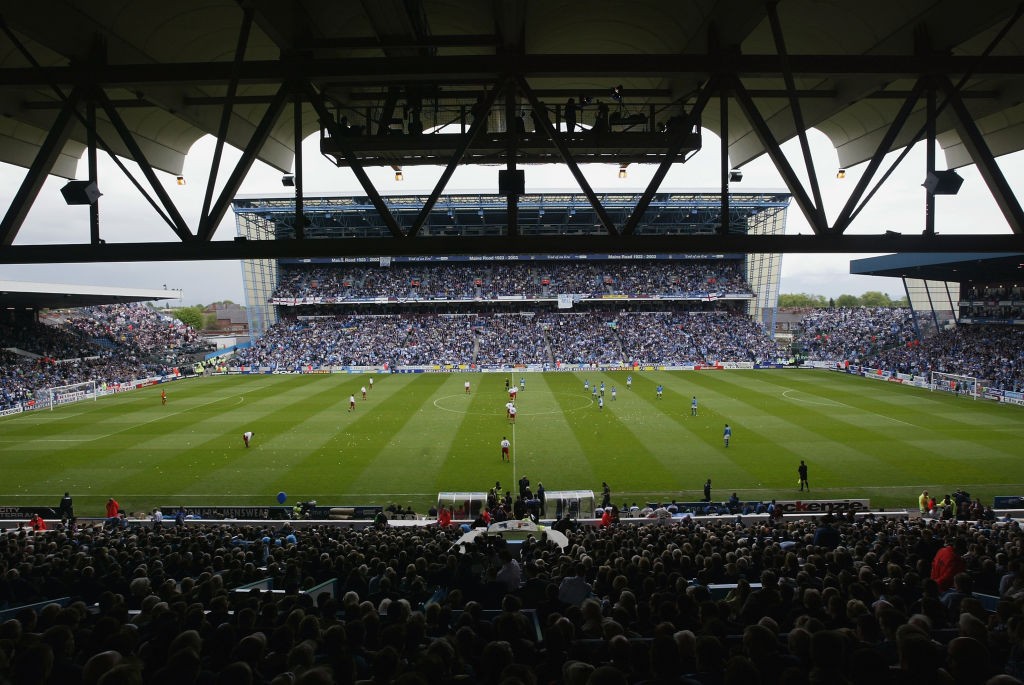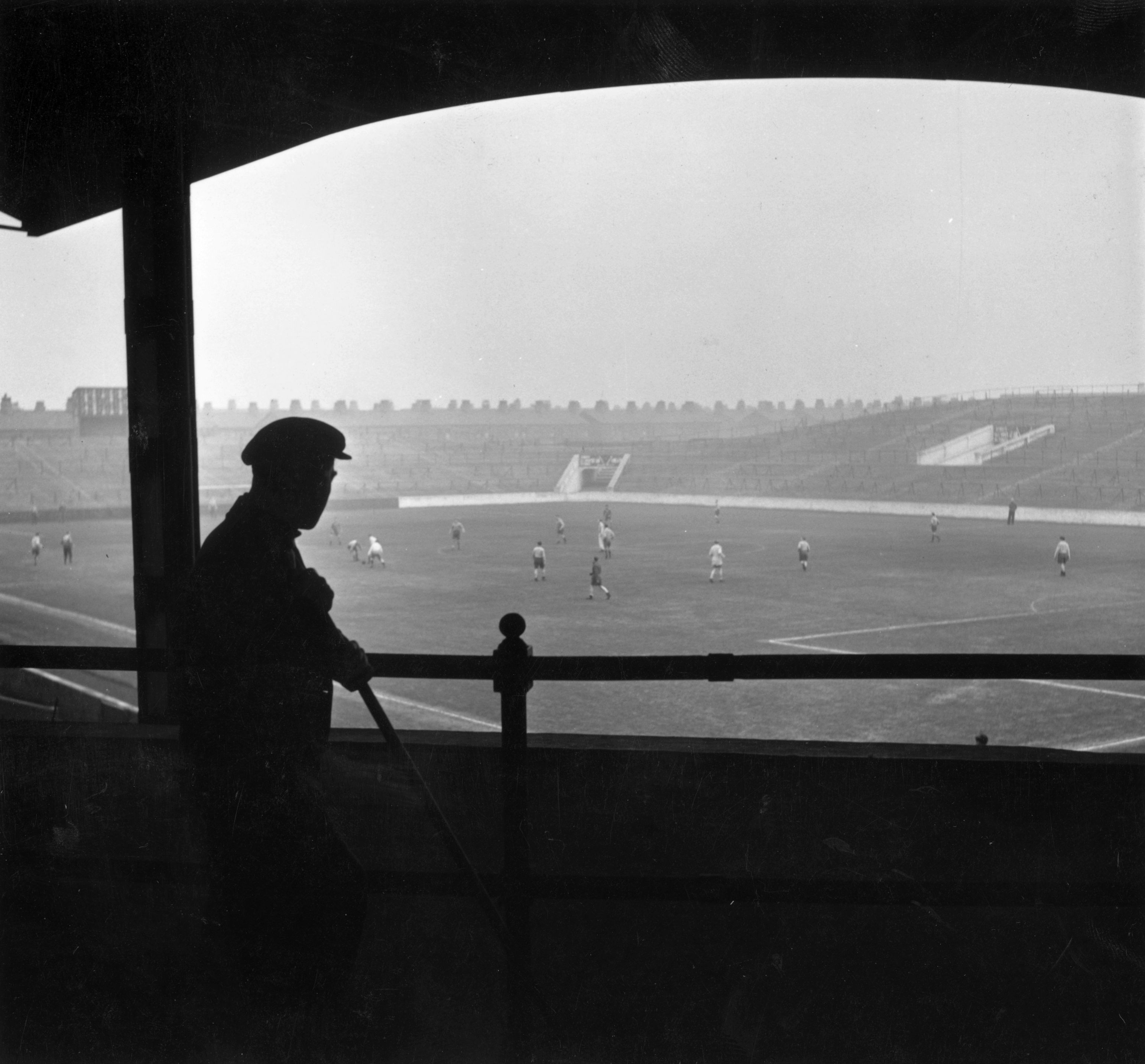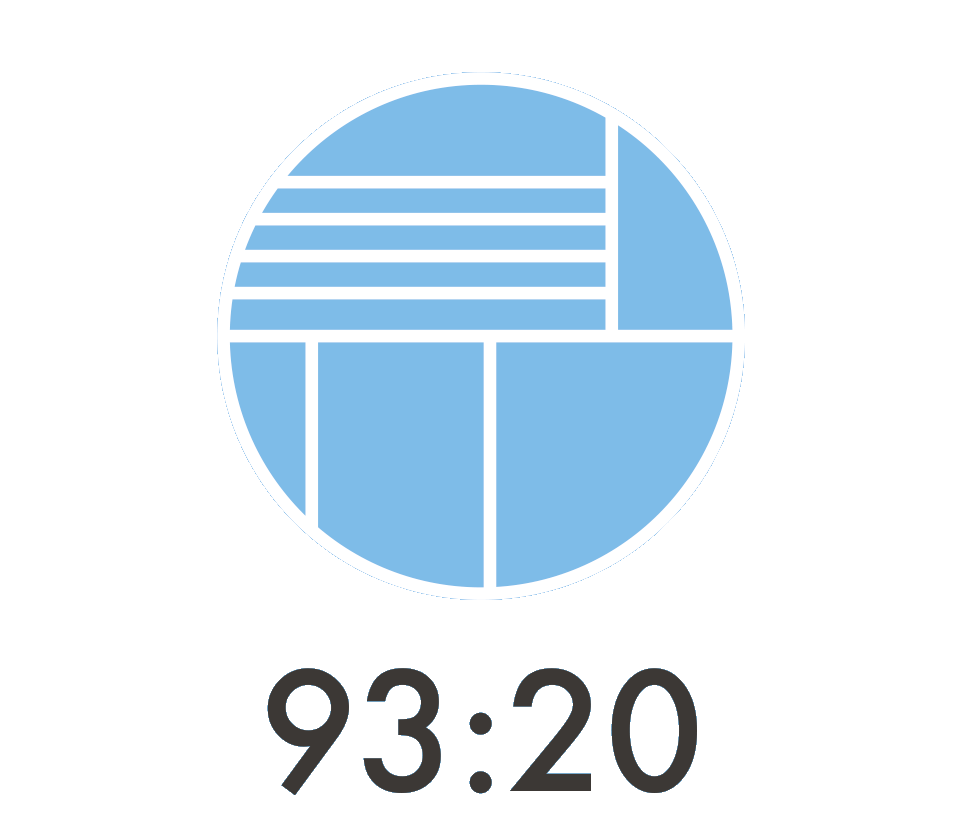A Look Back: Manchester City's Move From Maine Road
By Howard Hockin | 12 November 2019(Photo courtesy of Historic England)
The year is 1923. A huge new ground has been built and is ready to welcome the first football fans into its impressive space. Described as the greatest sporting arena in the world, it could hold 127,000 fans, though it is estimated over double that amount may have squeezed in for its first big match. The home of English football, Wembley, was born. But that same year, another iconic stadium was ready for action too, soon gaining the nickname The Wembley Of The North. Maine Road opened for business the same year, after Manchester City’s decision to move from their Hyde Road ground, a decision accelerated by damage to a stand from a fire in 1920. The land was bought for £5,500, the name Maine Road originating from the Maine Law in the USA in the 19th century, which spread prohibition around the states of the US. It was the Temperance movement in England that thus pushed for the name Maine Road, replacing Dog Kennel Lane some 50 years previously. And so for 80 years, Maine Road would be the home of Manchester City football club, and the home of many a sunken pint. Construction took 300 days, at a cost of £100,000.
And it was home for 80 years because as you will know, as Manchester City reached the end of the 2002/03 season, it was time to move on. To a new stadium, and to new experiences. It was a decision that had been long in the making. After all, the first suggestion that City would move to a new stadium came in the late 1980s. At that time Bob Scott, a key figure behind the resurgence of the Palace and Opera House Theatres laid out ambitious plans for Manchester to stage the 1992 Olympics. The plans were mocked by many Mancunians, and to be honest, who could blame us? The thought of Manchester hosting the Olympics was as crazy a notion as that of Manchester City dominating English football. Walter Mitty-style dreaming in a city that was ill-equipped to deal with such a massive event, as it staggered out of the bleakness that was the 1980s. Even today, as cranes continue to dominate the skyline, such an event is surely beyond the capabilities of a city that cannot even supply a regular tram service after a City match. Nevertheless, the Manchester Evening News focussed on the story, and linked city to the new stadium that such an event would require. £100m site for Blues? Was their headline, and City chairman Peter Swales was well up for it, kind of. “If it all happens and the stadium is built, it is something we have got to be interested in. It is at a very early stage. We have spent a lot of money at Maine Road and the new stadium would have to be something pretty special to make us move.”
Eventually an optimistic bid for the Olympics would be made for the 1996 event. Submitted plans included a design for an 80,000-capacity stadium on a site west of Manchester city centre. Atlanta won the bid. The council were undeterred and bid once more for the Olympics of 2000, with a stadium planned for a different site. The media coverage was positive, to the extent that I travelled down to Castlefield to watch the Olympic result with thousands of others, so confident was I of victory. Sydney won the vote. Nevertheless, the council was determined to host something, and the result was a successful bid for the smaller-scale Commonwealth Games in 2002. Its ramifications would help change the city and the history of the Citizens forever.
The Golden Games
The Commonwealth games would naturally still require the construction of a new stadium, and this is where the City chairman David Bernstein saw an opportunity for City. The stadium needed a role post-games, and City seemed the only viable option to make it cost-effective. Bernstein knew he held many of the cards when entering into negotiations, which would later lead to accusations of City getting very favourable terms. City didn’t need to move, but there was a feeling that to be a proper force in English football, City could not achieve this at Maine Road. There had been some plans to increase its capacity to 45,000, but the logistics were troublesome. In his autobiography, Kevin Keegan calls the move the deal of the century – “a stadium that cost £110m being given to us for virtually nothing” – though that rather overlooked the fact that City were not strictly speaking being given the stadium. Elsewhere, calls from the likes of Sebastian Coe and Jonathan Edwards for the stadium to become a hub for future athletics events were not really sensible. After all, how many spectators would end up filling seats, and how often, if the stadium had not been converted for football? Council chiefs realised this, and a conversion to a football stadium was seen as the only viable option. For the stadium to be used for both, thus requiring movable seating, it is estimated that £50m was needed. City didn’t have that money, and it’s unlikely they’d have offered it anyway, and nor did the council. Nor did City really want a dual-purpose stadium. If they were to move, and they did not have to, then the stadium would need to be just for them. Thus, in August 1999 Bernstein signed the legal documentation agreeing to the move. In fact, he signed it on the Maine Road pitch at half-time in City’s opening game of the 1999-2000 season. The following December Prime Minister Tony Blair laid the first stone of what was to become the City of Manchester Stadium. But first we would enjoy what would become known as the Golden Games, falling as they did in the Queen’s Golden Jubilee year. As for City, a new stadium was ambitious as they recovered from their nadir in the 3rd tier of English football. Gary James, in his book Manchester – The City Years, recollects Bernstein’s comments at the time in the match programme. “The stadium design has benefitted from fans’ feedback at last year’s open days. Its capacity should approach 50,000 and its facilities will be fitting for the next Millennium…I believe that the City of Manchester, the local community and our club will all derive enormous benefits from this exciting venture.”
By summer 2002 the stadium was a 35,000 seater athletics venue, and once the Games ended in August 2002, work commenced on re-configuring the stadium into a football venue. There was a year to complete the transformation. The original Commonwealth stadium consisted of a couple of two tier stands at the east and west sides, and a one tier South Stand. At the northern end a large temporary uncovered structure filled the end where the running track curved beyond the boundaries of a regular football pitch. An uncovered structure would not do in a city with Manchester’s climate. Work consisted of digging down (10m), rather than building up. The pitch level would be lowered, and three tiers created on the west and east sides of the stadium. The new capacity would be 48,000. It was a brave new world for City, but off the pitch, the problems continued. Bernstein resigned, with deputy Chairman John Wardle replacing Bernstein and Alistair Mackintosh ultimately becoming the Club’s Chief Executive. Mackintosh would now be tasked with much of the planning for the move. Bernstein cited a “divergence of views on fundamental strategic issues particularly concerning finance and management structure”. Bernstein was right of course. He realised that the club spending money it did not have or might earn thereafter was playing with the future of the club. City would be rather fortunate to get away with it later that decade. City also had a long-term loan with an American bank worth an estimated £50m. It was taken out against estimated increases in revenue when they moved into the Commonwealth Stadium the following season.
Over at the council, another blue and another Bernstein, namely Howard Bernstein, was key to negotiations. Bernstein was the Chief Executive of the council from 1998 to 2017. He ensured that City would show a continued and extensive commitment to the area where their new home would reside. This would start with the regeneration of Eastlands and go on to include a £1bn investment in housing for north and east Manchester over the subsequent decade. As for who paid for all of this, the details would be debated for many a year. The general understanding was that the council committed £22m to converting the stadium to make it fit for football, whilst City spent some £20m improving the facilities and the corporate areas. These are figures open to debate, depending on whether you are called David Conn or not. City would not own the stadium. Under the tenancy agreement, the council retained control of naming rights to the stadium, which remains a publicly owned asset. In 2011, City are thought to have agreed to a £2m annual fee to buy those rights off the council. Soon after, The Etihad was born.
Floods Of Tears
It’s hard to recall how the fans reacted to news that City would be leaving their home of 80 years. There was of course opposition to the move as fans were consulted about the plans. Nevertheless, there was something of a resigned acceptance that Maine Road was no longer fit for purpose if the club really wanted to go places. “Going places” seemed rather optimistic as a new millennium dawned, but hope remained that a move like this could push the club on to a new level. Eventually it would do just that. Kevin Keegan commented that he could understand the reticence of some fans to move. He could understand why it “caused so much heartache”, as Maine Road had charm and noise, colour and warmth. He said that from the moment you walked into Maine Road, you were made to feel welcome. According to Keegan, there were plenty of fans who opposed the move, coming up to him regularly close to tears, saying they didn’t want to leave. For fans it is the biggest of upheavals, changing your routine, your experiences as a football fan, changing everything bar the team.
And so the 2002-03 season would be the final season at Maine Road, under the guidance of manager Kevin Keegan. Some temporary seats were put in place to ensure as many as possible could witness the last games at the ground, taking the capacity up to 35,150, its biggest capacity since 1994. There may have been discord in the boardroom during this period, but on the pitch, Keegan’s exciting team consolidated their promotion the previous season with a 9th place finish in the Premier League. This of course included a famous 3-1 win over Manchester United, including one of Gary Neville’s lowest moments, robbed by Shaun Goater prior to one of the goals. The tannoy predictably failed pre-match, but this will only have helped with the atmosphere. There was plenty of looking back at the ground’s proud history as its life drew to an end, including an End of an Era memorabilia exhibition. Kevin Keegan would be the 31st and final manager to sit in the Maine Road manager’s office, the last one to gaze over the hallowed turf, 80 years after Ernest Magnall. The ground had changed hugely during its history. The Kippax was covered in 1956 before being completely rebuilt in the all-seater era, but the memories remained. John Wardle commented that it was time to move on however. “It was a wonderful experience moving. It was if you’d been living in a terraced house and were then given the keys to a five bedroom mansion.”
Towards the end of Maine Road’s lifespan there were proposals for other sports teams to make use of the stadium following City’s relocation. Stockport County expressed interest in moving there from Edgeley Park and in December 2000 Sale Sharks rugby union club was offered a lease for the stadium. A BBC article in 2000 quotes Stockport chairman Brendan Elwood’s interest in the move, with him even considering changing the team’s name to Man-Stock County. He said: “It’s an attractive idea because, to be honest, with the crowds and ground we have at Stockport we’ve been overachieving for the past few years. We feel we would be the best possible leaseholders and could bring more to the Moss Side area than anyone else who might be interested in taking over Maine Road.” However, none of the proposals came to fruition. Eventually Sale Sharks would end up at Stockport’s ground instead.

(Photo by Alex Livesey/Getty)
The Final Days
21st April 2003. Manchester City 3 Sunderland 0. As it turned out, Marc-Vivien Foe’s goal would be the last scored by a City player at the stadium. Just a week after the season ended, Foe would tragically die after collapsing playing for Cameroon at the Confederation Cup. Foe was on loan to City the previous season, though there was little indication of the deal being made permanent. City would later retire the number 23 shirt in his honour. A 1-0 home defeat to West Ham was followed by the same score line in City’s last ever game at Maine Road, against Southampton. A pre-match argument broke out over the away side’s ticket allocation, as City tried to get as many home fans as possible into the ground that day. A historic day where the football took a back seat, and as the music blared out post-match, the faithful shuffled away, never to return. Tears were shed, because nothing would be the same again. Mementos were taken, or bought at a later date, and one last look given to a place that ad given so much to so many.
And so to the future. The City of Manchester Stadium, or Eastlands as it was often called. An open day saw fans explore the new stadium and try out their new seats over the summer. The stadium was officially opened on Sunday 10th August 2003 when the Blues defeated Barcelona 2-1. Nicolas Anelka scored the stadium’s first goal in the 34th minute at the North Stand end, and Ali Bernarbia bowed out before moving to the Middle East. Four days later the first competitive match saw City defeat Welsh side Total Network Solutions 5-0 in the UEFA Cup Qualifying Round. European football was back, for now. The first football season at the stadium saw the Blues achieve their highest average attendance of all time (a record broken in the 2011/12 season). Keegan would not last for long, and nor would the entertaining football, as financial worries were never far from the surface. But in time, everything would change. A new tier would be added to the south stand, a new name would be given to the stadium, and new owners would change the course of the team forever. Super City, but not from Maine Road.
But what of Maine Road itself? The demolition of the stadium did not begin until 2004, over a year after the final match was played. After much ‘community consultation’, it was announced that a ‘modern housing complex’ would be built, which meant that rumours such as the one that Oasis were purchasing the site to turn it into a music venue, were unfounded. Building on the site would not begin until 2008 however. What’s more, the effect of moving was not one just felt by the fans. It was felt by the local Moss side community too, for the ground was the “heart and soul” of the area for many, including many a blue. “I still can’t believe it’s gone you know. I find myself just looking down the street and I can’t believe it’s not there anymore,” said one resident in 2004. A thesis submitted by Tanzima Rahman in 2010 to the University of Manchester about regeneration in Moss Side touched on the loss of Maine Road. “It’s like they’ve just torn the earth away from under us, you know. I mean, everything we believed in, everything my dad taught us to believe in, it all came from here. I mean, if you weren’t part of it, you might not get it, it held us together. It was everything.” said a man named Keith a year after the ground closed. Ex-players had their say too. “It’s a total waste,” said Paul Power. “I can put up with the fact City won’t be playing there anymore but I cannot see the point of knocking it down.” Others disagreed though, preferring it to be demolished rather than witness it slowly fall apart. And soon it would be demolished, a “sea of rubble at the end of the road”. And now, some 16 years later, the pubs are gone, the community changed, forced to adapt to a different world without a football ground, and all that brings. The housing estate, Maine Place, was built eventually, a small plaque where the centre circle once stood the only evidence of what once existed there. Gone from our sight, but not from our memory, 16 years ago the Wembley Of The North was no more.
———
Thanks for some fascinating insight into the period from Gary James, from his book Manchester – The City Years.
(https://www.amazon.co.uk/Manchester-City-Years-1857-2012-Text-ebook/dp/B00M74AHNW/ref=sr_1_5?keywords=gary+james&qid=1573489495&s=books&sr=1-5)

(Photo by John Chillingworth/Hulton Archive)
